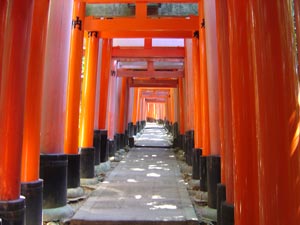kyoto
June 18, 2004

The morning after the Kobe conference finished, I went across to Kyoto – only about an hour by local train – to meet Ryoko sensei, who was my first Japanese teacher in Edinburgh. Although we’ve stayed in touch by email and postcard in the meantime, the last time I saw her was just before she left Edinburgh, about four years ago. We managed to meet up in Kyoto station by means of mobile phones (“Where are you? What can you see?”, “I’m… standing by a pillar, and I can see… what can I see? Taxis. Kyoto Tower Hotel… erm…”, and so on…). Very 久しぶり (hisashiburi), which means “long time no see” in Japanese. It was strange to think that last time we met, Japan was still just a sort-of imaginary place that I’d heard about and sometimes seen on tv, and now here we are, walking round actual Kyoto.
In fact, to make the most of being in Kyoto, we went for a wander around the grounds of Fushimi-inari Shrine (伏見稲荷大社). “Inari” (稲荷) means that it’s a fox shrine – dedicated to Inari, the deity of foxes, harvest, and prosperity. Unlike a lot of Kyoto’s other temples and shrines, Fushimi-inari isn’t particularly impressive on first sight. The interesting thing is not the shrine itself, so much as the torii (shinto gate) lined paths that wind through its grounds (as in the photo). Since Inari is a god of prosperity, lots of businesses pay to have one of these large, bright red gates built on the grounds of the shrine as an offering, and consequently the paths through the woods around it are lined with thousands upon thousands of gates, of various ages. Fushimi-inari’s amazingness creeps up on you gradually as you walk through the woods, and you begin to realise that the rows of torii just keep going and going. The day that I went there with Ryoko sensei, the weather was perfect: cloudless blue sky, bright sunshine, and just this side of too hot. The woods around the shrine were cool, with patches of bright sunlight scattered about, and the bright orange-red gates stood out beautifully against the bright green of the trees. I suppose Fushimi-inari (like other places in Kyoto) would be quite a different experience with each season – the constant orange of the gates set against a changing background of green summer leaves, red autumn leaves, snow, and then blossom. Have to go back to find out. The other thing I liked about Fushimi-inari is the feeling that it’s still alive: so many tourist attractions feel almost hermetically-sealed for posterity, but torii continue to be built, and further into the woods, they become more widely spaced out. So Fushimi-inari will presumably just keep growing out into the woods for a long time to come.